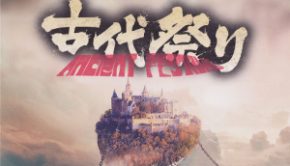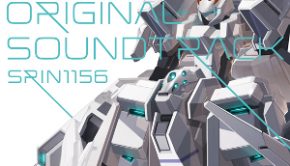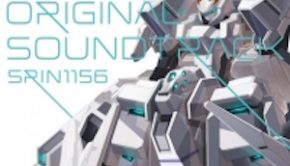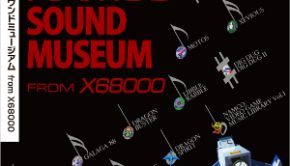Etrian Odyssey V -The End of the Long Myth- Original Soundtrack
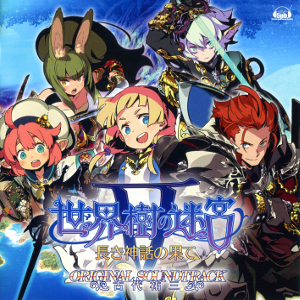 |
Album Title: Etrian Odyssey V -The End of the Long Myth- Original Soundtrack |
| Record Label: 5pb. Records |
|
| Catalog No.: FVCG-1397 |
|
| Release Date: September 28, 2016 |
|
| Purchase: Buy at CDJapan |
Overview
Yuzo Koshiro’s latest score to the Etrian Odyssey series is the fifth installment in the mainline series and, like the game, is more akin to the first three scores rather than the fourth, both in terms of structure as well as focus. While the fourth game in the series was absent an FM soundtrack, the fifth game does rectify this, albeit as downloadable content, by featuring both the original score as well as the FM synth DLC soundtrack, which is based off of the original score rather than vice versa. How does this soundtrack compare to the rest of the series?
Body
Following in the footsteps of all four games before it, “Labyrinth I – Guardian Spirit’s Woodlands” has that quintessential Etrian Odyssey sound first established with the original game’s release and even includes a musical throwback to that very theme in the opening of the tune. The piece is a beautiful piano, strings, and woodwinds driven theme with the jazzy influence heard in many of the series’ modern interpretations. “Labyrinth II – Shrine Road of Monoliths” features a bright melody dominated by woodwinds and piano. In addition, there is also a slower section that has a very nostalgic air to it led by strings. The end result is one of the highlights of the labyrinth themes. A departure from the more acoustic instruments is “Labyrinth III – Graveyard of Darkness” with its slow jam rock approach. The melody itself is strong, focusing on soft percussion, electric guitar, although still incorporating some of the jazzy piano that is frequently present on the album. Taking a similar approach to some of the music from Etrian Odyssey IV is “Labyrinth IV – Rainbow Druse,” with its more ethereal and softer sounds and less of a melodic focus in the early parts of the tune. The overall atmosphere is rather calming and relaxing and suits the beautiful melody quite well. “Labyrinth V – Primeval Forest Ring” also brings a beauteous sound with an almost heavenly sound, thanks to the subtle bells, slow tempo, and delicate violin work. As the piece progresses, it becomes a bit more pop/jazz like in approach, featuring more woodwind and piano. The final labyrinth theme, “Labyrinth VI – Redshift Corridor,” used in the extra dungeon after completing the main game fits its environs quite perfectly with its spacey intro and heavy electronic hits. The overall atmosphere is one that is menacing and dark. While it certainly lacks a strong melody, at least compared to the other dungeon themes, it still manages to succeed due to its other merits. In terms of the FM versions of these tunes, they translate quite nicely and are certain to please those who prefer the retro versions.
The most hit-or-miss section of music on the album definitely relates to the town themes. While there are certainly some successful town related music, such as “Town – Remembering the Names Passed Down,” with its militaristic approach and an exquisite B section focusing on brass, woodwinds, and strings that conjures up images of Dragon Quest, there are other town themes that falter, not due to their melody, but due to their execution. “Town – Source of the Morning Glow’s Smiling Face” features a saxophone lead that makes me feel like I’m on hold indefinitely while listening to Kenny G. It’s the type of muzak that is a bit too schmoozy for me. To its credit, the melody is strong and the B section, which shifts to a piano focus, due manage to save the track a bit. The same saxophone stylings of “Town – Waning Twins’ Party” also bring it into muzak territory, perhaps even more egregiously, as the melody for this tune isn’t nearly as strong. Fortunately, “Town – The Light That Once Shone” offers a similar sound to something found on Etrian Odyssey IV with its beautiful woodwind led melody that has a bit of a mysterious air to it. The FM versions of these tunes certainly help mitigate some of the problems of the instrumentation, but at the same time, that muzak-y feeling is certainly still present, but at a more tolerable level.
The battle themes in the game serve up the standard fare for the series, providing a mix of rock and orchestral tracks, depending on their use. The first normal battle theme, “Battlefield – Activation” features a guitar lead with accompanying jazzy piano and strings. The melody itself is fantastic and also features some wonderful guitar and piano solos. The second normal battle theme, “Battlefield – Life or Death Struggle to Seize the Future” has a similar chord progression to Etrian Odyssey IV’s “Battlefield – Faith Is My Pillar” with a guitar and saxophone led melody with a super catchy sound while also featuring some excellent solos. The final normal battle theme, used in the extra dungeon, is “Battlefield – Shining Dagger, Shadow Blade,” which features organ and rock and has a very chaotic sound. It’s most similar to the first game’s extra dungeon normal battle theme and is quite discordant overall. Of the normal battle themes, it is certainly the weakest. There is also the special battle theme, “Unrest – End of the Raging Waves (Arranged Version),” done by Takeshi Yanagawa and originally hailing from Etrian Odyssey III. This is similar to the version in the fourth game, but adds choir into the mix. The end result has a very Falcom-esque sound that manages to keep the energy of the original quite nicely.
The game’s FOE theme, “Battlefield – Critical Situation,” has a more chaotic sound mixing strings, drums, synth, guitar, and keyboards to create a suitably appropriate tune, but doesn’t have the iconic sound of some of the earlier games’ FOE theme. The normal boss theme, “Unrest – Empty Ringing, The Earth Splits,” is more in the vein of the typical series battle theme, sporting an orchestral tone. It’s a brass forward melody that happens to be extremely memorable, but at times, does sound a bit cliche. The game’s final boss theme, “Unrest – Ordeal of Stars” makes me feel as though the final boss is a two part battle. The first half of the track is quite dramatic, featuring choir and piano, and gives off a bit of a Shin Megami Tensei: Strange Journey vibe to it. The first part drags on a bit long, for my tastes, and is a bit unremarkable. However, the second half is much more engaging, in terms of melody, instrumentation, blending orchestral, choir, and rock to create an extremely powerful sound with an excellent melody. The extra dungeon final boss theme, “Unrest – Lord of the Beyond,” references the regular boss battle theme, which I think is a nice touch, and opens with a dramatic, yet soft, sound featuring a beautiful and mysterious melody, particularly in the first half. The latter half adds choir and more menacing elements. The end result is decent, but certainly not one of the highlights.
The two ending themes, “Triumph Together Under Our Banner” and “End of the Long Myth” differ in their execution. The former is a more militaristic tune with a joyous, celebratory melody with a brass focus. Included in the theme is also the staple victory theme that is incorporated effortlessly. The piece also offers some softer moments in contrast with the heavier sounds. The latter is a beautiful piano, woodwinds, and strings driven piece that features a great melody and also gives off a sense of closure. When it comes to the FM versions of the tunes, they largely mirror their instrumental counterparts, however, there are some examples where the FM versions are, in my opinion, better. While the muzak-y nature of the town themes is still retained in the FM versions, the fact there isn’t a saxophone lead in this case helps make it sound a bit more appealing, in my opinion. Another example where I think the FM version is superior is the FM version of “Unrest – Ordeal of Stars,” where it focuses more on the latter half of the piece and doesn’t spend as much time on the slow build. As for the rest, fans of the series who were missing the FM versions from the fourth game should be pleased with the inclusion here.
Summary
The end result for Etrian Odyssey V is one that is certainly in tune with the rest of the series. In many ways, it contains a lot of influence from the previous four games in the series, more so for the first three games rather than the fourth, but also retains its own identity. While some of the tunes do manage to become a bit more muzak compared to predecessors, the FM versions do help mitigate that somewhat. Fans of the series will certainly find something to enjoy on this soundtrack, whether it be the instrumental versions, the FM versions, or a mix thereof.
Do you agree with the review and score? Let us know in the comments below!
4.5
Posted on April 19, 2017 by Don Kotowski. Last modified on April 18, 2017.

